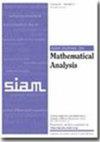A New Divergence-Curl Result for Measures. Application to the Two-Dimensional ODE’s Flow
IF 1.9
2区 数学
Q1 MATHEMATICS, APPLIED
引用次数: 0
Abstract
SIAM Journal on Mathematical Analysis, Volume 56, Issue 5, Page 6398-6421, October 2024.Abstract. The paper is devoted to divergence-curl results involving a divergence free measure-valued field [math], where [math] is a signed Radon measure on [math] and [math] is a nonvanishing regular vector field in [math], and a gradient measure-valued field [math] on [math], [math]. On the one hand, in a nonperiodic framework we prove that for any open set [math] of [math], the orthogonality condition [math] in [math] implies the equality [math] in [math]. The key ingredient of the proof is based on the existence of a representative in [math] of the bounded variation function [math] in [math]. This result allows us to extend in the setting of ODE’s flows the famous Franks–Misiurewicz theorem, which claims that the Herman rotation set of any continuous two-dimensional flow on the torus [math] is a closed line segment of a line of [math] passing through [math]. Moreover, this nonperiodic divergence-curl result can be applied to a finite almost periodic bounded variation function [math] and to a finite almost periodic measure-valued field [math]. On the other hand, in the periodic case with dimension [math], assuming that [math] is absolutely continuous with respect to Lebesgue’s measure on the torus [math], we prove that if the product [math] is the zero measure on [math], so is the product of the [math]-means [math].
新的度量发散-卷积结果。二维 ODE 流的应用
SIAM 数学分析期刊》,第 56 卷第 5 期,第 6398-6421 页,2024 年 10 月。 摘要。本文主要研究无发散量值场[math](其中[math]是[math]上的有符号拉顿量值,[math]是[math]中的非消失正则向量场)和[math], [math]上的梯度量值场[math]的发散-卷积结果。一方面,在非周期性框架中,我们证明了对于[math]的任何开放集[math],[math]中的正交条件[math]意味着[math]中的相等条件[math]。证明的关键要素基于[math]中有界变函数[math]在[math]中的代表存在。这一结果使我们能够在 ODE 流的环境中扩展著名的弗兰克斯-米苏雷维茨定理,该定理声称环[math]上任何连续二维流的赫尔曼旋转集是[math]的一条通过[math]的封闭线段。此外,这个非周期发散-卷积结果可以应用于有限的几乎周期的有界变化函数[math]和有限的几乎周期的量值场[math]。另一方面,在维数为[math]的周期情形中,假设[math]相对于环上的勒贝格度量[math]是绝对连续的,我们证明,如果[math]的乘积是[math]上的零度量,那么[math]-均值[math]的乘积也是零度量。
本文章由计算机程序翻译,如有差异,请以英文原文为准。
求助全文
约1分钟内获得全文
求助全文
来源期刊
CiteScore
3.30
自引率
5.00%
发文量
175
审稿时长
12 months
期刊介绍:
SIAM Journal on Mathematical Analysis (SIMA) features research articles of the highest quality employing innovative analytical techniques to treat problems in the natural sciences. Every paper has content that is primarily analytical and that employs mathematical methods in such areas as partial differential equations, the calculus of variations, functional analysis, approximation theory, harmonic or wavelet analysis, or dynamical systems. Additionally, every paper relates to a model for natural phenomena in such areas as fluid mechanics, materials science, quantum mechanics, biology, mathematical physics, or to the computational analysis of such phenomena.
Submission of a manuscript to a SIAM journal is representation by the author that the manuscript has not been published or submitted simultaneously for publication elsewhere.
Typical papers for SIMA do not exceed 35 journal pages. Substantial deviations from this page limit require that the referees, editor, and editor-in-chief be convinced that the increased length is both required by the subject matter and justified by the quality of the paper.

 求助内容:
求助内容: 应助结果提醒方式:
应助结果提醒方式:


